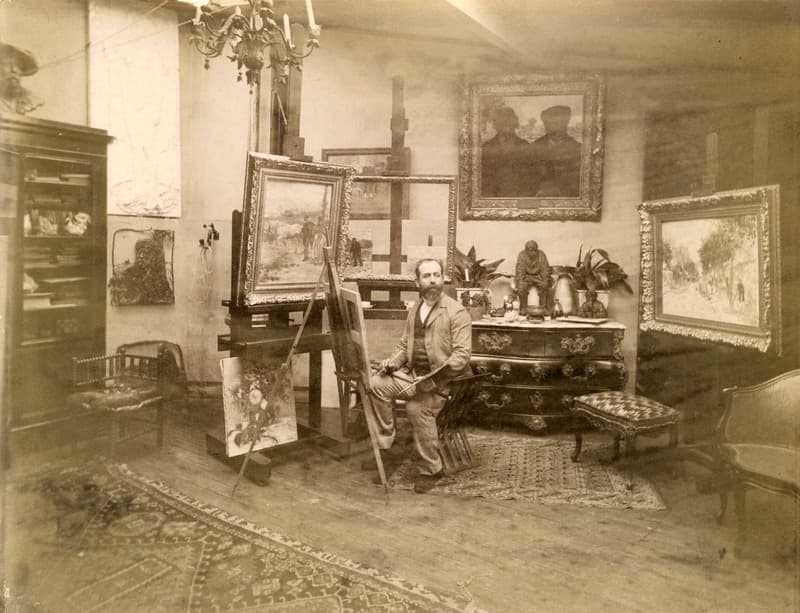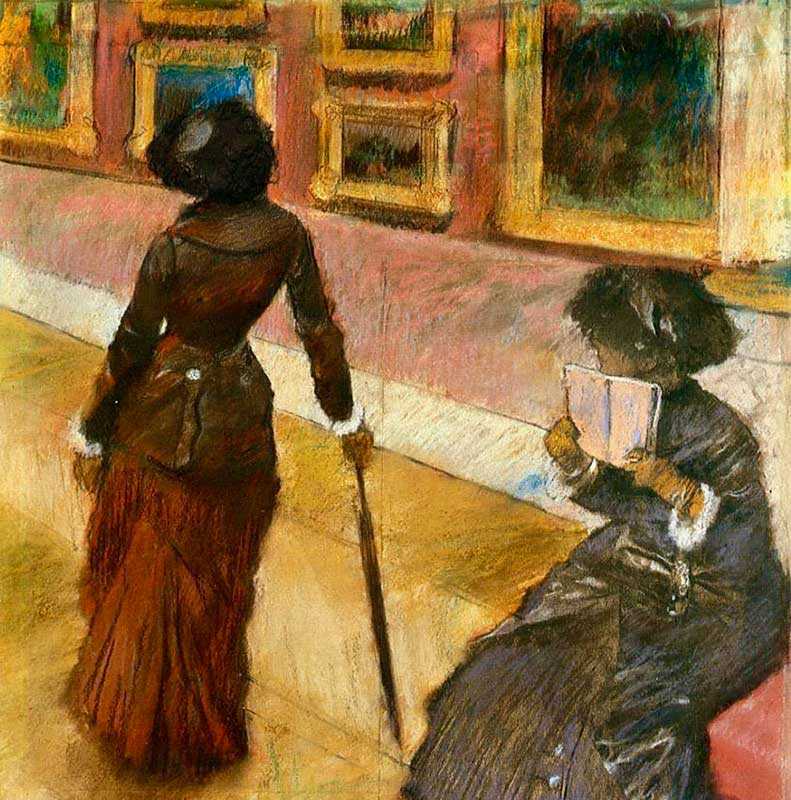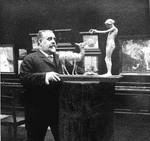1. The loss of Monet
In 1880, Monet made the decision to submit some of his paintings to the Salon.
No doubt motivated by Renoir’s 1879 success with Madame Charpentier and her Children, Monet resolved to once again establish ties with the institution that he had so long been against.
His excuse was that he hoped his presence in the Salon would convince Paul Durand-Ruel’s primary competitor, Georges Petit, to buy some paintings from him. However, given that Petit had already purchased three pictures from Monet in January 1880, his true motivations remained unclear.
Change to the Salon rules
It is most likely that Monet had been convinced by a recent change in the Salon rules, which granted artists who had exhibited three times before the right to do so again. Monet had exhibited at the Salon three times, in 1865, 1866 and 1868. He took advantage of the opportunity and sent a range of artworks to the panel, but the jury only accepted one.
In the Salon exhibition, his submission was so badly hung that it could barely be appreciated due to the poor lighting. Nonetheless, the effort was not entirely in vain as Charpentier saw his work and offered him a solo exhibition at ‘La Vie Moderne’, his ultra-fashionable new gallery attached to his publishing house.
Though he had abandoned the Impressionists, Caillebotte continued to pay Monet’s rent and finance his visits to Paris.
Degas' reaction
Degas was stung by what he saw as Monet’s betrayal.
He severed his ties with Monet and publicly condemned his infidelity. The loss of Monet from the Impressionist camp meant that very few of the original group remained: only Morisot, Camille Pissarro, Degas, and Caillebotte, with the addition of Armand Guillaumin and Henri Rouart.
Pissarro, the oldest in the group, was the only individual who depended on painting for his livelihood; he made enormous financial sacrifices, living in poverty in order to maintain his loyalty to the Impressionists. Caillebotte, the youngest in the group at just 32, supported him when he could.
2. Organising the Fifth Impressionist Exhibition
The Fifth Impressionist Exhibition opened on 1st April in a gallery at 10, rue des Pyramides.
The title chosen for this exhibition was simply ’La 5e Exposition de peinture par…’ Posters were printed in bright red lettering on a green background - perhaps borrowing from Mary Cassatt’s frames in the previous Impressionist exhibition.
Poster design
There was some debate surrounding the posters for the exhibition as Caillebotte and Degas disagreed over whether or not to include the names of the major exhibitors. Caillebotte insisted on the move in order to give the artists more publicity. Degas wrote frustratedly to Felix Braquemond,
“When will people stop wanting to be stars.”
As Morisot and Mary Cassatt were partly responsible for financing the exhibition, they requested not to have their names displayed on the posters as they felt it would be unethical.
Similarly, Marie Bracquemond had decided to include a painting in the exhibition as a late submission so her name was also missing from the posters. As a result, the exhibition posters went up with the names of all three women absent. The billboards did grant a great deal of publicity to the as yet unknown Paul Gauguin, however, who contributed six works to the exhibition.
The opening date of the show was also planned to mark the launch of the group’s publication dedicated to the art of printing - ‘La Jour et la nuit’. Unfortunately, the work was stalled by Degas, perhaps due to a lack of funds.
The Difficult Degas
Cassatt had poured her energy into bringing the publication to fruition and she was hugely frustrated by Degas’ indifference. The affair is best described in a letter written by her mother, Katherine Cassatt, to her brother, Aleck Cassatt, in Philadelphia.
She describes,
“Degas, who is the leader, undertook to get up a journal of etchings and got them all to work for it so that Mary had no time for paintings, and as usual with Degas when the time came for it to appear he wasn’t ready, so ‘Le Jour et la nuit’, which might have been a great success, has not yet appeared. Degas is never ready for anything.”
Matters were made worse by the fact that by this point, Cassatt regarded Degas as a close family friend. He visited the Cassatt household frequently, for dinners, private viewings and the theatre. Cassatt gladly modelled for his paintings and they had become completely absorbed in the work of the journal for many months. She was therefore stung by his apparent disregard of the project and their friendship became extremely strained.
It was eventually decided that the etchings would be framed and hung alongside the paintings in the Fifth Impressionist Exhibition, so that their work would not be entirely in vain. The etchings were then be printed in the journal after the event. This was the first and only issue of ‘La Jour et la nuit’ to be produced.
3. The Artists
The most important feature of the Fifth Impressionist Exhibition was arguably the empty spaces.
The exhibition lacked the work of Monet, Renoir and Sisley, who had all made the decision to exhibit with the Salon and had become separated from the group in the process. The Impressionist exhibition was the first of its kind to be missing Monet’s work.
New Talent
In their absence, the group welcomed new talent into the group. As well as the core Impressionists - Degas, Caillebotte, Morisot and Pissarro, with the recent addition of Cassatt - there were also a number of newcomers. These included friends of Charles-Victor Tillot, who had exhibited with the group before, Jean-François Raffaëlli and Eugène-Vincent Vidal.
Vidal had enjoyed success at the Salon in previous years, but he was permitted to exhibit nine works with the Impressionists.
Raffaëlli, a friend and protege of Degas, had somewhat tenuous links to Impressionism. Many of his works were realist and lacked any Impressionist influence at all. To make matters worse, he had also had very little to do with the group prior to the exhibition. In total he showed 35 works, overwhelming the group with his submissions and causing discontentment among the original Impressionist artists.
Morisot and Pissarro
In contrast, Morisot and Pissarro contributed just over a dozen artworks to the exhibition. Gauguin, who Pissarro had been patiently mentoring, was represented by a still life and a number of landscape paintings, as well as a polished marble bust of his wife Mette, from 1877. Despite the contributions, the absence of Renoir, Sisley and Paul Cézanne were sorely felt.
Disorganised Degas
As in previous exhibitions, Degas was once again famously disorganised and failed to deliver on many of the artworks he had promised. The catalogue showed his works to be far more than were actually present. This included most starkly a sculpture of a young dancer for which a glass case had already been placed in the exhibition hall. The case remained empty throughout the exhibition.
Degas did exhibit some of his paintings of Cassatt, including ‘Cassatt At The Louvre, Musée des Antiques’ (1879-1880) and an etching of Mary and her sister Lydia at the Louvre. Meanwhile, Pissarro chose to hang his paintings in white frames to help them stand out in the exhibition and his etchings were printed on yellow paper with purple frames.
4. Response to the Fifth Impressionist Exhibition
Generally, the exhibition was far less popular than its predecessor. Visitor numbers were lower, which meant that takings were also lower.
This may have been due to the exhibition space, located on the second floor of a residential building, rather than being accessible directly from the street.
Unsuitable Premises
To make matters worse, the building was also under renovation, so visitors were disturbed by constant noise and vibration from the works. Some critics commented on the poor lighting and unplanned manner in which the paintings were hung in the space. It is possible that these less extravagant premises were a reflection of Caillebotte’s already strained budget, as a result of supporting Monet.
Signac
One notable attendee to the Fifth Impressionist Exhibition was a 19 year old boy, who Gaugin caught sketching one of Degas’ paintings. In a rough-handed manner, Gauguin reprimanded him for copying Degas’ works and escorted him out of the exhibition. This young artist was Paul Signac.
Meh
Overall, the exhibition was characterised by indifference by the public. It did not receive its usual scorn, which of course was a good thing, but it did not receive much praise either. The response was lukewarm at best. In the eyes of the public, Manet was still regarded as the leading figure of the group, even though he had never fully believed in the Impressionist cause, nor ever exhibited in their independent exhibitions.
The Press
Unfortunately, the press was no more forgiving of the Fifth Impressionist Exhibition than they had been in previous years. The scourge of Albert Wolff continued when he wrote,
“one only finds canvases without the slightest value, works by madmen who mistake pebbles for pearls.”
Nevertheless, he did spare a line for Morisot and Degas before quickly resuming his tirade, stating that,
“The rest is not worth viewing and even less discussing. It is pretentious nonentity.”
Of the critics who were loyal to the Impressionists, there was a great deal of discussion about who in the group was a true Impressionist and who did not belong in the exhibition. Armand Silvestre, for instance, credited Pissarro with being the one artist who had remained faithful to the original aims of the Impressionists, despite the passage of time.
Limitations of Impressionism?
On the other hand, a review penned by Odilon Redon centred on the limitations of Impressionism, questioning, and to a certain extent dismissing, the entire foundation of the movement. He wrote that Impressionism,
“is a very legitimate mode of painting when applied mainly to the representation of external objects under the open sky. However, I do not believe that all which palpitates under the brow of a man who meditates and listens to his inner voices […] can gain much from this tendency of observing only what is happening outside of our walls.”
He finished by stating that, “To the contrary, the future belongs to a subjective world.”
Huysmans
One of the most detailed reviews of the Fifth Impressionist Exhibition was penned by Charles-Marie-Georges Huysmans. In his writing, Huysmans countered any praise of the Impressionists with caveats and jibes, generally summarising that they had not succeeded in their aims of
“representing beings and things dissolved in the powdery sparkles of light, or of showing them in crude colours, without gradations, without half tones, beneath certain rays of the sun which shorten and almost suppress shadows, as in Japanese prints.”
He went on to criticise the work of Berthe Morisot in particular.
More divisions
Degas and his camp of followers, including Raffaëlli, did receive some praise in Husymans review. This was indicative of a divide that had appeared in the Fifth Impressionist Exhibition between the Impressionists and the artists who only marginally spoke to the aims of the group. Thus, it somewhat confirmed the fears of the Impressionist artists that Degas’ insistence on fresh talent would dilute the central message of the movement.
Husymans also found space to compliment one of Gauguin’s works ‘Study of a Nude’, from 1880, of which he wrote,
“Here is a girl of our time, who doesn’t pose for an audience, who is neither lascivious nor affected, who is simply concerned with mending her clothes.”
This life-size study showed the teaching of Pissarro and also the influence of Renoir on Gauguin’s style.
Praise for Morisot
Similarly, Morisot’s ‘Jeune femme en toilette de bal’ or ‘Young Girl in a Ball Gown’ from 1879 was also praised by some critics, even while others stated that she had completely lost any talent she once had. The beautiful painting of a woman in a ballgown fused the Impressionist style with the influence of Manet’s art on her work. It is a free and candid painting that contrasts heavily with the official portraits on display in the Salon.
Charles Ephrussi in the ‘Gazette des Beaux-Arts’ wrote a highly poetic description of Morisot’s oeuvre on display at the Fifth Impressionist Exhibition. He described how,
“Berthe Morisot is very French in her distinction, elegance, gaiety and nonchalance. She loves painting that is joyous and lively; she grinds flower petals onto her palette, in order to spread them later on her canvas with airy, witty touches, thrown down a little haphazardly. These harmonise, blend, and finish by producing something vital, fine, and charming”.
Morisot also successfully sold a number of her paintings at the exhibition, including ‘Young Girl in a Ball Gown’ to Giuseppe de Nittis, an Italian Impressionist painter.
5. The Aftermath
The Fifth Impressionist Exhibition was largely a disappointing venture. It demonstrated more than ever the precariousness of the movement and laid bare its failures thus far.
Though there had been some successes, none of the artists were in the position they had hoped they would be in by the summer.
Destructive Degas?
Caillebotte was frustrated by Degas’ influence in the group. He could not forgive him for pushing out Monet, one of the founders of the movement, but accepting numerous followers and acquaintances into the exhibition. In Caillebotte’s eyes, Degas’ influence was a key reason for the lack of success of the Fifth Impressionist Exhibition and he could not forgive him.
Despite Monet’s decision to leave the group and exhibit at the Salon, there was very little evidence that his career was faring any better than his fellow Impressionists. Several impressive paintings, including ‘The Break-Up of the Ice Near Vétheuil’ from 1880, were rejected by the judging panel. Furthermore, in his solo exhibition organised by Charpentier, he failed to sell a single painting.
Following the exhibition, many of the Impressionist artists dispersed across France for the summer months. Cassatt’s brother, Aleck, brought his family to France to visit his sister. The whole Cassatt family stayed in Marly-Le-Roi for the summer, where Mary spent much of her time painting her family and her nieces and nephews in particular. Her relationship with Degas remained frosty.
Caillebotte seizes back control?
Though the Fifth Impressionist Exhibition could not have been called a success, Caillebotte was insistent on staging another exhibition. He was determined to see the movement rise to fame, this time with real Impressionist artists, not randomly selected individuals from Degas. Hence, by the winter of 1880, he was already asking the Impressionists when they would hold the Sixth Impressionist Exhibition and making plans for an impressive show.



















